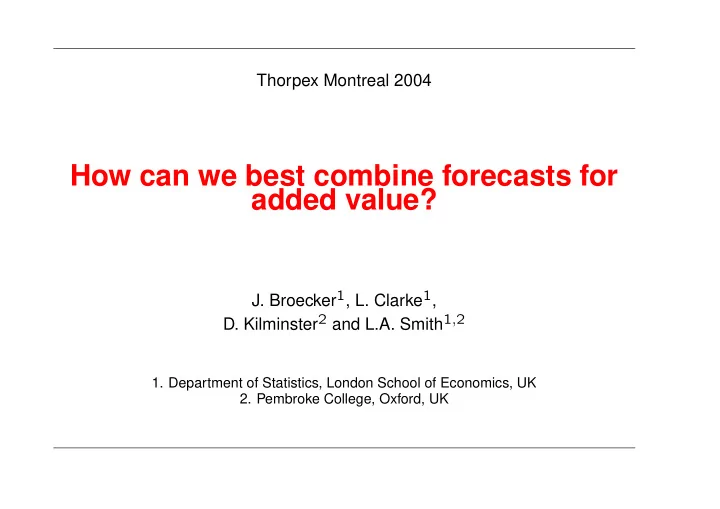

Thorpex Montreal 2004 How can we best combine forecasts for added value? J. Broecker 1 , L. Clarke 1 , D. Kilminster 2 and L.A. Smith 1 , 2 1. Department of Statistics, London School of Economics, UK 2. Pembroke College, Oxford, UK
Thorpex Montreal 2004 How can we best combine forecasts for added value? How might we use TIGGE? J. Broecker 1 , L. Clarke 1 , D. Kilminster 2 and L.A. Smith 1 , 2 1. Department of Statistics, London School of Economics, UK 2. Pembroke College, Oxford, UK
Motivation 1 Forecast improvement can be achieved in two ways: Motivation Overview Combining Evaluation Example
Motivation 1 Forecast improvement can be achieved in two ways: Motivation Overview • improving the models (strategic) Combining Evaluation Example
Motivation 1 Forecast improvement can be achieved in two ways: Motivation Overview • improving the models (strategic) Combining • using the available information more effectively (tactical) Evaluation Example
Motivation 1 Forecast improvement can be achieved in two ways: Motivation Overview • improving the models (strategic) Combining • using the available information more effectively (tactical) Evaluation Example THORPEX : “THORPEX will develop, demonstrate and evaluate a multi-model, multi-analysis and multi-national ensemble prediction system, referred to as TIGGE.”
Overview 2 • Combining Simulations Motivation • Evaluation Overview – skill scores → Broecker – bootstrapping and meaningful skill comparison Combining • Example - combining ECMWF and NCEP Evaluation Example
Inputs 3 Motivation Climatological Distribution Overview Combining Evaluation Example
Inputs 3 Motivation Climatological Dressed Point Distribution Forecast Overview x Combining Evaluation Example Roulston & Smith, Tellus 55 2003 Raftery et al. Univ. Washington Dept. of Stat. Tech. Report 440 2003
Inputs 3 Motivation Climatological Dressed Point Ensemble Distribution Forecast Product Overview x x x x x x x x x x x Combining Evaluation Example Roulston & Smith, Tellus 55 2003 Raftery et al. Univ. Washington Dept. of Stat. Tech. Report 440 2003
Inputs 3 Motivation Climatological Dressed Point Ensemble Distribution Forecast Product Overview x x x x x x x x x x x Combining Evaluation Example Combined Forecast Roulston & Smith, Tellus 55 2003 Raftery et al. Univ. Washington Dept. of Stat. Tech. Report 440 2003
Combining: Skill Scores 4 The combination is based on the skill of the Motivation final forecast Overview Combining s = S ( f, o ) Evaluation forecast distribution f Example verifying observation o skill score S skill of forecast f s
Combining 5 One combination method is to take a weighted sum of the component distributions Motivation � f = α i f i Overview Combining Choose α i that maximises the skill score � s � = max �S ( f, o ) � Evaluation Example over a set of historical forecast-verification pairs Ignorance : s = − log p ( o ) Roulston & Smith, Monthly Weather Review 130
Evaluation:Bootstrapping 6 Motivation Overview Combining Skill Evaluation Example Model A Model B Model C Out of sample, particular location, particular lead time, particular target
Evaluation:Bootstrapping 6 Motivation Overview Combining Skill Evaluation Example Model A Model B Model C Out of sample, particular location, particular lead time, particular target
The Right Comparison 7 We do not want to compare the uncertainty in the average performance of two models. Motivation Overview We want the uncertainty in the comparative Combining performance of the models to each other. Evaluation Bootstrap the difference: � s A − s B � BS Not the difference of the bootstraps: � s A � BS − � s B � BS Example
Comparative Skill 8 Motivation Overview Comparitive Skill Combining Evaluation Example A vs B A vs C B vs C
Example 9 Predicting temperature at Heathrow. Motivation Using Overview • NCEP high resolution • NCEP ensemble • ECMWF high resolution Combining • ECMWF ensemble Evaluation Evaluating using Ignorance - out of sample Example
Example - one lead time 10 Motivation Overview Comparitive Skill Combining Evaluation Example Lead Time (Days) Combination vs NCEP Hi Res. IGN: smaller = good
Example - one lead time 10 Motivation Overview Comparitive Skill Combining Evaluation Example Lead Time (Days) Combination vs NCEP Hi Res. Combination vs NCEP Ens. IGN: smaller = good
Example - one lead time 10 Motivation Overview Comparitive Skill Combining Evaluation Example Lead Time (Days) Combination vs NCEP Hi Res. Combination vs NCEP Ens. Combination vs ECMWF Hi Res. IGN: smaller = good
Example - one lead time 10 Motivation Overview Comparitive Skill Combining Evaluation Example Lead Time (Days) Combination vs NCEP Hi Res. Combination vs NCEP Ens. Combination vs ECMWF Hi Res. IGN: smaller = good Combination vs ECMWF Ens.
Example - all lead times 11 Motivation Overview Comparitive Skill Combining Evaluation Example Lead Time (Days) Combination vs NCEP Hi Res. IGN: smaller = good
Example - all lead times 11 Motivation Overview Comparitive Skill Combining Evaluation Example Lead Time (Days) Combination vs NCEP Hi Res. Combination vs NCEP Ens. IGN: smaller = good
Example - all lead times 11 Motivation Overview Comparitive Skill Combining Evaluation Example Lead Time (Days) Combination vs NCEP Hi Res. Combination vs NCEP Ens. Combination vs ECMWF Hi Res. IGN: smaller = good
Example - all lead times 11 Motivation Overview Comparitive Skill Combining Evaluation Example Lead Time (Days) Combination vs NCEP Hi Res. Combination vs NCEP Ens. Combination vs ECMWF Hi Res. IGN: smaller = good Combination vs ECMWF Ens.
Summary 12 We have: Motivation • presented a user-orientated methodology for com- bining simulations • whatever combination method, the evaluation must Overview be robust • dressing method, combination method and size of Combining forecast-verifi cation archive affects performance • potential relevance to TIGGE, provides a frame- Evaluation work for allowing users to extract the forecast in- formation most relevant to them Example
Recommend
More recommend